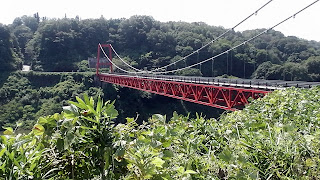 |
| Map Location. |
Along the first 5-kilometers of track I was to experience an assortment of Shinto & Buddhist Stone Markers. These are always a favorite of mine as one can come-across them in some of the most isolated of places.
 |
| Map Location. |
In places the path becomes narrow and overgrown and, all around me, is evidence of a typhoon that had just passed over a few days prior to my visit. I had one narrow escape, as can be seen on the video, of where I nearly cycled into a fallen tree.
Immediately below me, on my left, is the Kizugawa River. I am always mindful, when cycling along tracks such as this, to be aware of others, especially hikers. Medical treatment in Japan is very expensive and the cost of paying someones hospital bills would leave a very large hole in my bank account.
I soon pass through the settlement of Minamiokawara and my first junction of the day. About 4-kilometers along route-82 the Tokaido Road and I part company, at . . . .
 |
| Map Location. |
 |
| Map Location. |
 Two kilometers further up-the-road I arrive at this impressive bridge that spans Lake Tsukigase. On the far side is my destination - Tayama. But, before I cross, I take a moment to soak-in my surroundings. If I only had a kayak.
Two kilometers further up-the-road I arrive at this impressive bridge that spans Lake Tsukigase. On the far side is my destination - Tayama. But, before I cross, I take a moment to soak-in my surroundings. If I only had a kayak. As you can see in the satellite-image, Gongen-jinja is very isolated, to say the least and, upon arrival, you can't help but get the impression it has seen better days. But the surrounding views and the serenity makes one appreciate the beauty of the countryside.

I am particularly intrigued with this Chozuya. As there was no visible water system, I assume someone brings some in a pail or rainwater is the other option.With all this beauty and serenity surrounding me, what better location to break for lunch.
My return to the settlement, and my next shrine in the area, is via an alternative lane - quite possibly the one my farmer friend used earlier - but, before entering Suwa-jinja Shrine, I stop to admire the stone markers at the entrance.
I am impressed with this Sekibutsu as it hasn't been carved into solid rock, but what looks like a slab of rock. The L-shaped slab wouldn't be more than 3-cm thick.
Suwa-jinja is very imposing, not just for it's size and grandeur, but how it overlooks the settlement of Tayama. Wherever one stands in the town, the shrine is there for all to see.
Just off the main street of Tayama, is this disused elementary school that has been taken-over by several craft shops and this . . . .
. . . . quaint cafe. Walking into Cafe Nekopan was like going back 50-years, to when I attended Primary School at Dunsandel. It just seems like it was yesterday. The cafe has a very-appetizing menu and I highly recommend to anyone who is likely to be in the area.
After a glass of ice-tea, courtesy of the owner, I move on. By this point I have clocked-up 50-kilometers and am still a long way from home. But, as I still have the energy, I decide to take another route back to Kasagi and more sightseeing.
 |
| Map Location. |
An hour, and three hill-climbs later, I arrive at the town of Yagyu. The town was made famous for housing one of the oldest schools of swordsmanship in Japan - Yagyu Shinkage-ryu.
But it's this Sekibutsu that I am keen to revisit, as-well-as have a bite to eat and take on water. This stone marker is very significant to those trying to conceive. What you do, is come here, along with a tray of Tofu, place the tray at the base of the icon, pray, then go away and hope for the best.
From here to Kasagi it's downhill all the way. I arrive at the bridge that I departed from four-and-a-half hours and 37-kilometers earlier and am praying I have a tail wind home. The trip along route-163 - a busy highway at the best of times - can be hell if there is a head wind. But the gods are on my side and I am helped all the way home.
So, until next time,
Sayonara.
Video - https://www.youtube.com/watch?v=9TWME855DFc












No comments:
Post a Comment